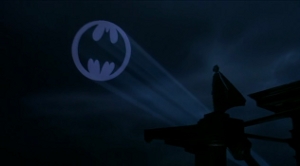 So it’s 1989 and I’m six years old. For my birthday I’m allowed the fifty-mile car ride down to the nearest theater to see one film. Like every other kid in 1989, I chose Batman and one of the results of that choice is the website you see today.
So it’s 1989 and I’m six years old. For my birthday I’m allowed the fifty-mile car ride down to the nearest theater to see one film. Like every other kid in 1989, I chose Batman and one of the results of that choice is the website you see today.
It’s impossible to underestimate the historical importance of this film. We have to remember that, before 1989, the only superhero to achieve real success in the only true mass medium was Superman. And before 1989, Superman was a fluke: a one in a million shot, barely duplicated thanks to the decision to split the first movie into two. A creation of the go-go Regan years that was already on its last legs in 1987, when Christopher Reeve’s ego and Cannon films horrible habit of embezzlement brought Superman IV: The Quest for Peace down upon us all.
Before this film, Batman’s only real cultural cache came from Adam West’s notorious TV show, which remained popular enough to justify continuous re-runs on at least one channel per year since is original cancellation. Burton changed all that, and in one film he rescued the Golden Age of American superhero movies from history’s dustbin. Shame about the film, eh?
It’s ironic that Burton claims to this day that he’s not a comic book fan, but that makes perfect sense in context. Warner Brothers originally tapped him to direct Batman after Pee-wee’s Big Adventure became a smash hit in 1986, indicating the suits viewed Burton as young and inexperienced talent, a magician who could turning small piles of cash into large ones. Someone they could control. If we might slip into George W. Bush’s argot, Warner Brothers “misunderestimating” Tim, and Batman languished in development hell for another six years while everyone argued over what to do.
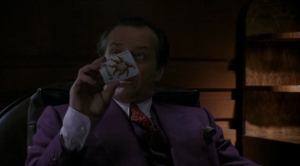
This proved to be fortunate as it gave the film time to hire the two people who would ensure it’s success: Jack Nicholson and Michael Keaton. Nicholson’s casting earned praise from film buffs who, by this point – twenty years after Easy Rider and nine after The Shining – would’ve watched a shirtless fat man jog if he has Jack Nicholson’s face tattooed on his stomach. But howls of protest from Batman’s fan base greeted news of Keaton’s casting, unfortunately reinforcing (or creating) the pop-culture stereotype of the Comic Book Nerd as Prejudiced Complainer in the minds of a national audience. A comedic actor, primarily known at the time as Mr. Mom, Keaton looked far too lightweight to carry a role like Batman. This makes the fact he wound up defining Batman as a role for an entire generation of actors, including several who still play Batman today, so deeply and abidingly ironic, Batman fans still haven’t taken the lesson of this episode to heart, and continue to broadcast their identities through the medium of armchair cast-directing, sometimes years before the Bat-movie in question even comes out.
All this despite the fact that – no matter how many times Danny Elfman’s score sounds those triumphant notes – this really isn’t Batman’s film. It’s a film everyone has seen at least twice, but I’m surprised by how few notice how thoroughly it shafts it title character, using only the barest dabs of lubricant. That’s a testament to Batman‘s overall quality, but narrative choices made here would go on to have unfortunate implications for superhero movies in general and Batman’s movies in particular. Yes, his name’s in the title and the movie opens with one of the most iconic sequences in the genre, wherein we watch Our Hero take down some muggers on a rooftop. Then, like any good masked vigilante, he disappears for the next twenty minutes so the film can set up its real characters.
Oh, but they’re all looking for Batman, you see, so the title still kinda counts. The choice to make Batman’s identity a key mystery was both pragmatic and short-sighted. Screenwriter Sam Hamm, who inherited the project after the usual flurry of re-writes and rumors of re-writes, felt telling an straight origin story, a la Richard Donner’s Superman, would destroy Batman’s credibility…Yes, Hamm actually worried about impugning the credibility of a character who spends his nights gliding around rooftops in a bat costume, looking for street-trash to beat up. Go ahead: laugh. I do. It’s funny…now put that aside and ask yourself, “Does Hamm have a valid point? Or was that just a screenwriter’s bullshit rationalization? I mean – some of us might say Batman’s lack of credibility is the whole point of him…but whatever…
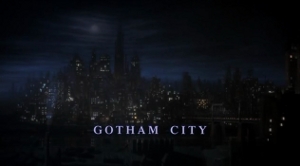 We open with a young couple and their young son attempting to return home from a night at Gotham City’s famous Monarch Theatre. They’re accosted by two hoods who are in turn accosted by Batman. Even though we didn’t know it at the time, the movie is telling our brain Batman’s origin story in the midst of introducing him. It’s also setting up the most important character in the film: Gotham City.
We open with a young couple and their young son attempting to return home from a night at Gotham City’s famous Monarch Theatre. They’re accosted by two hoods who are in turn accosted by Batman. Even though we didn’t know it at the time, the movie is telling our brain Batman’s origin story in the midst of introducing him. It’s also setting up the most important character in the film: Gotham City.
You know what I really love here? The art direction. It’s not the neon nightmare Joel Schumacher constructed, or the bland, Chi-York-adelphia Christopher Nolan seems to love: Burton’s Gotham is a city all its own, the southern forty-most blocks of Manhattan stretched out over miles and miles…filling up with spires and creepy-faced, Art Deco statues…overbuilt and oppressive…it looms at you…like the Batman himself…going so far as to almost completely overshadow him.
This film ensured every subsequent superhero film would have at least one Obligatory Mugging in an Obligatory Dark Alley, but unlike it’s imitators, Batman‘s Obligatory Mugging not only tells us who and what Our Hero is (“badass”) it tells us why he is by telling us everything we need to know about Gotham. It’s a place where people are stupid enough to take short cuts through dark alleys and get mugged. It’s a place where the “spare any change?” bums all carry pistols. Fans of the comics know that, even in its home universe, Gotham is considered to be more of an open wound than a functioning polis. I really can understand why Tim Burton found that more fascinating than some rich guy with issues (a lot of issues)…but it makes the overall film seem more like a slice-of-life piece than an actual narrative. Pieces of it are downright ethnographic.
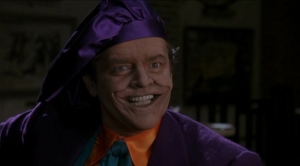
Like the fundraiser scene, where Gotham’s Mayor openly admits his city is “synonymous with crime” to the assembled rich twits. Way to fire up your supporters, there, Your Honor. He passes the mic to Our New District Attorney, Harvey Dent (Billy Dee Williams), who goes on to make a speech announcing his crusade against mob boss Carl Grissom (Jack Palance).
Grissom’s right hand man, Jack Napier (Nicholson), who’s boning Grissom’s blond bombshell behind the boss’ back, is nonplussed by the new DA’s civic boosterism. Despite this, when he confronts the mob’s pet cop, Lt. Eckhardt (William Hootkins), Jack seems concerned about Dent’s investigation, to the point of leaning on Eckhardt about it. Eckhardt changes the subject, questioning Napier’s sanity, and the two have a pissing contest over their relative place in the Gotham City mob hierarchy. Napier wins because he’s Pimp of the World and even has the purple suit to prove it, bitches! Ahhhh yeah!
But up in Grissom’s office, Nicholson sets the dial back to Bored. Seriously, Harvey Dent himself would have trouble keeping up with these mood swings. Jack even tries to weasel out of leading an evidence-destroying raid on mob front company, and recent Dent-target, Axis Chemicals. Grissom insists ‘cuz he knows Napier and Sugarbumps are shacking up together and you never rub another man’s rhubarb.
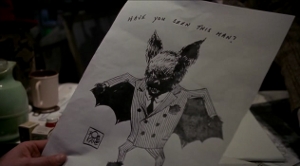
Meanwhile, be vewwy, vewwy quiet: Alexander Knox of the Gotham Globe is hunting Batmans. Or “Batmen” I guess. He gets back to his desk and finds he really can make girls appear out of thin air by wishing really hard while he stands at the urinal trying to keep his eyes forward. Actually, this is Vicki Vale (Kim Basinger), though not exactly the Vicki Vale from the comics. Yes, she’s a photojournalist who’s credits (thank you, Knox) include Vogue and Cosmo. But she’s also recently returned from a war-torn nation with a name that’s someone’s reference (maybe even Burton’s) to an Italian adventure comic book from the 1960s. She’s got a portfolio full of mass graves to prove it. One of her photos even made the cover of Time, so I think it’s safe to call her the Tim Burton Identification Character. She’s got the kind of job Lydia Deetz would pray for if Lydia didn’t already have a magical ghost for a best friend.
She also has tickets to Bruce Wayne’s upcoming charity benefit at Stately Wayne Manor, natural habitat of Gotham’s political and social elite. Vicki and Knox slip in hoping for at least a quote and maybe a break in their Giant Bat story. They manage to meet Bruce Wayne, who starts his relationship with Vicki off on the right foot by lying to her about his identity…
“Can you tell me which one of these guys is Bruce Wayne?
“[blink][blink]…Well I’m not sure.”
“Thanks anyway.”
…and it’s hard to know whether this lie is intentional or not. First-time viewers are only meant to chuckle at how Vicki’s inherent hotness ties Bruce’s tongue. Those of us who know Batman as a character (and actually give a shit about how he’s portrayed, insomuch that we prefer he be portrayed intelligently) have to wonder if Bruce is already running a con on Miss Vale. After all, he’s Bruce Wayne! Surely he can see/hear/smell a photojournalist coming from the next palatial mansion over…and maintain his cool to her face if he really wanted to…no matter how many acres of chest her dress shows off…but this is a case of the film’s theme getting in the way of its characters.
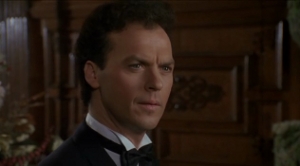
Bruce has to respond with “Well, I’m not sure,” because this film goes out of its way to show that, really, he isn’t. And that’s the only good reason I can find for his infatuation with Vicki.
We catch up with a character who’s actually important back at Axis Chemicals, where a platoon of crooked cops ambushes Jack Napier and his crew, led by Lt. Eckhardt…who’s got orders to kill Napier direct from Boss Grissom himself. Commissioner Gordon leaves Wayne’s party and makes it to the chemical plant in an effort to capture Napier alive. But, as usual, everyone’s plan goes tits-up thanks to the goddamn Batman. Napier shoots Eckhardt and, when he attempts to shoot Batman, a ricochet catches him in the face. Staggered, he tumbles off a catwalk and falls into a vat of…something…only to emerge as Batman’s most enduring and popular nemesis.
Nicholson’s Joker is easily the most fascinating character in the film, all the moreso since the script was specifically beefed up to take advantage of his star power. His performance did for the Joker exactly what Keaton did for Batman, and staring at him is still the same hypnotically entertaining, but decidedly creepy, experience. Joker’s commercial interruption of Action News is a picture perfect piece of black comedy, made more menacing by being unrepentantly silly. Pieces of this performance – like the a gag where Joker lights a table’s worth of candles with a flamethrower – always bring a smile to my face. They’re spot-on, absolutely true to the character, and because this is a film, Joker’s freed from comic book censorship standards of the time to become a…weirdly believable monster, surface details aside.
A lot of that has to do with how Nicholson chose to play Jack Napier in these early scenes. You get a real sense that here’s a guy who supposedly has it all, but he can’t enjoy any of it… apart from those bits that revolve around hurting people, because he’s a true sociopath. Napier only really comes alive when he’s lording over Eckhardt, and even then only when Eckhardt pulls a gun on him. Being a narcissist and a criminal, Napier no doubt spent his life doing horrible things in the name of cultivating his image as the dapper, 1940s gangster-about-town, facing stiff competition from every other ambitious thug in Gotham. Finding himself stripped of all that after his little dip in the industrial vat (and over a woman – a woman!) it’s no wonder he goes insane, and sets out to teach Gotham a lesson in the perils of vanity by poisoning the everyday household beauty products we all rely on to look good in public, the way he never can again. The product’s very ubiquity is part of “the gag” as he helpfully points out for the audience. “Chances are, you’ve bought ‘um already!”
My only concern is this old comedic axiom: if you have to explain a joke, then there is not joke!
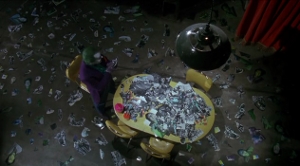
Returning from the dead, Joker obviously avenges himself upon Grissom, takes control of Gotham’s criminal operations through one of the best monologues ever, and consolidates that control by staging an ostentatious hit on his main competition on the steps of City Hall. That’s all fine and dandy. In fact, it’s vintage Joker: an outrageous act concealing a very pragmatic goal we’re not supposed to have time to think about with all the gunfire and death going on. But as with all good tragedies, Joker’s success plants the seeds of his downfall. By absurd Movie Coincidence, Bruce Wayne is also present during the attack. (Cynical, mock-gasp.)
We have to back up a bit here. Earlier, Bruce invited Vicki over for a dinner date. They stayed up past Alfred’s bedtime listening to the old butler (the under-used but always wonderful Michael Gough, Gods rest his soul) tell embarrassing stories from Bruce’s youth, got smashed on red wine, and one thing led to another. The next day, Bruce lies to Vicki again in order to try and get some distance back, visibly perturbed that he’s let himself slip so far into a relationship…even though it’s not really all that far. Unless the sex was just that good. (I’ll bet the Drakes heard this photojournalist coming from the next palatial mansion over. Buh-dum-tish.)
Vicki follows boning Bruce with a day of trying to bone up on him, only to discover there’s nothing on Bruce Wayne in the Globe‘s main files. “No photos, no history, no nothing. Who is this guy?” Knox asks “Who cares?” but Bruce Wayne’s identity has just become the film’s key B-story. In fact, Burton tries to shoehorn this into the proceedings so hard it breaks all the bounds of logic. How could there be “no photos, no history, no nothing” about Bruce Wayne in the main offices of his home town’s major daily newspaper? For Christ sake, he’s Bruce Wayne, the Prince of Gotham. He’d have to go a thousand miles just to find somebody who didn’t know his name. But that might be too interesting for a film so concerned with the keeping up of appearances.
So Bruce has to become the Phantom of the Opera. Alone in his castle with his case files, his arsenal, and his butler…he even went to the same store where the Invisible Man got his giant sunglasses. Greeted by the complete failure of Gotham’s journalistic community, Vicki uses this as an excuse to follow Bruce down into Crime Alley…which is just down the street from City Hall, it seems. There Bruce can stand around like a lummox staring at the inexplicably-alive Jack Napier. Way to stick out in a crowd, smart guy. It’s called a “secret identity.”
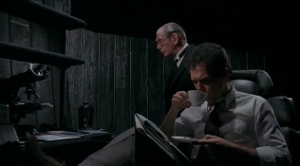 For the film to make its point, Bruce has to remain a mystery to Vicki and to the audience, seriously undermining his chances of being Our Hero. If his Tragic Past were public knowledge from the beginning, Batman would have no thread to string its numerous action scenes. There’s no mystery once the Joker becomes what we all know he is from the moment we see him…or so the film makers thought. It’s exactly the kind of thought a non-comic book fan would think, missing the entire point of comic book storytelling.
For the film to make its point, Bruce has to remain a mystery to Vicki and to the audience, seriously undermining his chances of being Our Hero. If his Tragic Past were public knowledge from the beginning, Batman would have no thread to string its numerous action scenes. There’s no mystery once the Joker becomes what we all know he is from the moment we see him…or so the film makers thought. It’s exactly the kind of thought a non-comic book fan would think, missing the entire point of comic book storytelling.
I’m not saying the fight scenes aren’t glorious. They certainly showcase Batman’s physicality in a way certain other directors don’t seem to have time for these days. But, like Bruce’s presence at City Hall at just the right moment, they’re contrived in the extreme.
Example: Vicki phones Bruce, telling her she’ll be late to their date at the art museum – the Flugenheim, which is apparently right down the street from the Monarch Theatre, which is next to Crime Alley, which is next to City Hall, because this Gotham, like most cities, really is just a small town when you get right down to it. Vicki gets there, sits down, and waits for Bruce until a package arrives. It’s a gas mask. She puts it on. The Joker gasses the museum, defaces the paintings, tries to recruit Vicki, tries to burn her face off with acid, and then – only then – does Batman come to her rescue.
It’s still the best entrance in superhero movie history. But honestly, how long did it take the World’s Greatest Detective to figure out the Joker’s set-up and get over there? Was he really, truly, washing his tights? Or could no one think up a better way to pace this part of the film?
In any case, Batman gives Vicki the key to the Joker’s “poison code,” further antagonizing the mad man. No matter what he says, Joker’s even more of a narcissist now than he ever was as Grissom’s Number One Guy. And here Burton introduces another key theme he’d go on to explore at length in the next film: Gotham’s only big enough for one costumed crazy person.
This comes when Joker preempts an announcement from Gotham’s Mayor Borg, canceling the city’s 200th Anniversary Festival…
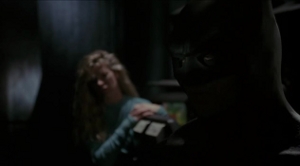 Wait… “Mayor Borg”? What the hell was his campaign slogan? “Your culture will adapt to service us”? No wonder this town’s falling down around everyone’s ears.
Wait… “Mayor Borg”? What the hell was his campaign slogan? “Your culture will adapt to service us”? No wonder this town’s falling down around everyone’s ears.
Never mind. Now that he’s got the establishment pissing down their legs, Joker announces he’s throwing a little festival of his own, complete with $20 million of the mob’s money, which he promises to dump on anyone fool enough to show up. All in an effort to gas them, of course. Batman has to stop it, Vicki gets kidnapped, Batman rescues her, Joker dies, and suddenly everyone loves Batman now for some reason. I guess the people of Gotham really enjoy tying lunatics to gargoyles.
But you see what I mean about Gotham being a character? And by God is it ever a vain, greedy, corrupt, evil place. People actually show up for the Joker’s party. Here’s a guy, he’s poisoned the city’s entire supply of hairspray, but one fireside chat on the TV (and over the radio – remember the days when radio still mattered? Or the days when Batman’s plane could be taken out with one shot?) and suddenly everyone’s A-OK with the Clown Prince of Crime riding a float full of henchmen right down the city’s main drag? To add insult to injury, the cops only show up after Batman crashes a plane at the foot of Gotham City Cathedral. You’re telling me a known murderer announces when and where he’ll be making a public appearance and Commissioner Gordon isn’t waiting for him with a SWAT team? Fuck you, movie.
Knox headlines it “Gotham’s Greed,” but really it’s Tim Burton showing us how he feels about this urban cesspool he’s stuck filming for his Overlords. The common herd are easily led, swayed by the vagaries of their ill-informed perceptions. That’s why they need a big, strong man in a mask and cape to protect them from the forces of Crime. Or so Frank Miller would have us believe. The fascist overtones of Miller’s 1986 miniseries The Dark Knight Returns were obviously foremost in Burton’s mind during this film’s conception. Where did you think that shot of Batman standing in front of the Big Red “AXIS” came from?
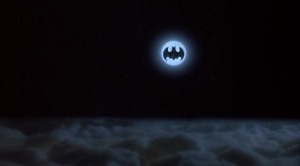 No wonder this town produces more psychopaths than D&D, “violent” video games, and shitty rap-metal combined. All of it “protected” by a lunatic in a fright costume who’s such a big fan of Dracula he went and built his own crypt, right under the family castle. No wonder they love him for summarily executing a motherfucker. After all, he sent them a letter! What more could he do to express his civic pride than murder a murderer and then admit it in black and white…on paper he then mailed to the cops. This Batman and this Gotham deserve each other.
No wonder this town produces more psychopaths than D&D, “violent” video games, and shitty rap-metal combined. All of it “protected” by a lunatic in a fright costume who’s such a big fan of Dracula he went and built his own crypt, right under the family castle. No wonder they love him for summarily executing a motherfucker. After all, he sent them a letter! What more could he do to express his civic pride than murder a murderer and then admit it in black and white…on paper he then mailed to the cops. This Batman and this Gotham deserve each other.
As do Batman and the Joker. I love how Bob, the Joker’s Number One Guy (the understated-but-excellent Tracey Walter) seems to function as the Joker’s Alfred. You get the sense he reloads the guns, resets the spring-loaded boxing gloves, and keeps the joy buzzers charged just on the off-chance the Boss might call for them. I love how Joker’s other thug, Laurence, gets to carry the soundtrack around in his plus-sized Ghetto Blaster. This Joker may not be the one I prefer – that’d be Mark Hamill’s – but he’s certainly the one I’d want to work for. He almost makes it through the picture without killing a single henchman. Sure, he sends a lot of them to death…but what else are they for?
And what the fuck is so special about Vicki Vale? So she’s a reporter. So what? She’s the luckiest goddamn reporter this side of Metropolis. Big deal. Why is Bruce so damn fascinated with her? Again, he’s Bruce Wayne. He must’ve met celebrity photographers before. What makes him so tongue-tied over this one? ‘Cuz she’s a blond, yeah, yeah, yeah? What on God’s gray and foggy Earth do these two possibly have in common? Other than the fact that they’ve both seen horrible shit in the course of their work? Not that Bruce can just tell her that. Again, it’s called a “secret” identity for a reason.
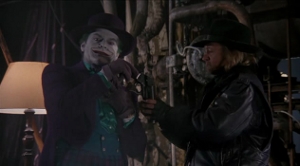 Ah, but Contrived Movie Law dictates that he will eventually, or we won’t have our Happy Ending…to the love story that’s shoehorned into this film for no reason, other than desperation. Alfred’s the one who lets her into the Batcave and fuck me running, I could not countenance that at age six and I cannot do it today. It’s a bullshit, sentimental resolution to a needless, Designated Love Story that only exists because creative types insist on believing Batman is unrelatable to the average moviegoer. Why? Just because he’s rich and insane?
Ah, but Contrived Movie Law dictates that he will eventually, or we won’t have our Happy Ending…to the love story that’s shoehorned into this film for no reason, other than desperation. Alfred’s the one who lets her into the Batcave and fuck me running, I could not countenance that at age six and I cannot do it today. It’s a bullshit, sentimental resolution to a needless, Designated Love Story that only exists because creative types insist on believing Batman is unrelatable to the average moviegoer. Why? Just because he’s rich and insane?
Not that the film helps, injecting the Batman mythos with the best, warmed-over ’80s Action Movie cliches. That’s why this Batman kills people. That’s why there are guns on the Batmobile. That’s why Vicki becomes useless in the Second and Third Acts, save as a distraction (frankly, as a character, that’s all she is). That’s why Joker henchmen can teleport up into the Cathedral’s belfry for that Climactic Action Sequence…after Joker’s taken out the stairs. That’s why the Joker’s ultimately revealed to be the man responsible for killing Batman’s parents.
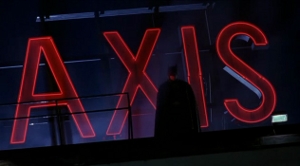
And that’s why I can’t give this film a perfect score. I would’ve at age six, but I didn’t know any better. It’s still the aesthetic high water mark of the Superhero Movie’s Golden Age and, thanks to this, a historic film in its own right. It’s still more fun than a barrel of other movies with Batman’s name on them, more fun than it really has any real right to be.
But the truth is everyone involved got lucky. The made the Batman movie everyone could enjoy, no matter their level of investment in the character. It still is that film today, and a personal hallmark of my own nostalgia. So despite the fact that I’ve spent the last two weeks wondering about its every nook and plot-hole, it’s still required viewing for all good little nerds out there, if only to show what can be done with this genre…and explain what has been done with it ever since.
![]()
![]()
![]()
![]()

“Or the days when Batman’s plane could be taken out with one shot?”
Yeah but did you see that gun, man?!
lol
Good review of the 2nd best Batman movie. Are you going to do MotP, or is that not worth it since it’ll get a perfect score anyhow?
Duh, now I see that you’ve already done it. Silly me!
Yes, and I’d be very glad to get your opinion on that piece, as well.
This movie totally blew me away as a kid… the mood and the fun of the movie make it enjoyable. The next day after I saw it, I went shopping with my mom… dressed up as the Joker! lol
However, my favourite Batman movie, now as an adult, is Batman Returns.
About three years ago, I would’ve agreed with you wholeheartedly about Returns preeminent place in the Batman movie pantheon. Then I watched Mask of the Phantasm again and it made me cry tears of fanboy joy, something Returns was not designed for at all. So we’re both in for a treat of sorts in a few days here, once I put that other Captain America review to bed. At the very least I hope you’ll consider it a treat, no matter how snarky I get with that film. Frankly, I’m amazed I got away with half the shit I piled on this one. Guess I’m still not popular enough to generate the kind of Fanboy Rage other people complain about. (Oh, to have other people’s problems.)
Oh yeah, Mask of the Phantasm.
Well, that’s my favourite *animated* Batman movie (wish I had it on dvd…) When it comes to live-action, though, it’s Returns.
Yeah, I gave up making a distinction between animation and live action a long time ago. Blame anime. It’s what I do.
Though I still love this movie, the only thing I have come to really hate about it was the finally confrontation between Batman and Joker. A few one liners are exchanged and Joker stupidly falls off a helicopter. Kind of a downer.
By the way, have you ever noticed this film’s key sequences were plucked from this film and used in Nolan’s work ? Ras Al Ghul poisons the city like Joker poisoning the crowd at the festival. Also, Joker and Batman have two very similar confrontations in both films.
As you can probably tell, there’s plenty enough in this Batman to bring me down, including the ending, about which we pretty much agree. On the small screen and (obviously) in comics, Batman’s adventures only occasionally end with the kind of knock-down, drag-out fight scene American Action Movies spend their length building up to. And we love him for it. In fact, fanboys and -girls are quick to point out Batman has the best Rogues Gallery in comics…which is funny when you consider how few of them could (physically) hold their own against the Dark Knight. Even the boss fights in Batman’s only good video game (to date), Arkham Asylum, often come down to sloughing through an army of thugs while the actual antagonists stands in the background hurling cheap insults. (Or, as is the case here, dancing with a lady-person.)
But movies are a different beast, and the plotlines of movies on this scale are usually designed by committees of ignorant fools who believe The Great Unwashed lack basic human empathy. They believe that audiences just won’t give a shit about anything less than the destruction of an entire city. So every masked idiot in Gotham has to become a terrorist bent on Gotham’s destruction. That way, sheeple won’t have to strain their teeny, tiny widdle minds wondering about little things like nuance. The laziest example of this is, of course, Batman & Robin, where Freeze and Ivy team up to both (a) freeze the city solid and (b) turn it over to the Plant Kingdom. Because those aren’t mutually-exclusive goals. No potential for conflict there at all if you believe the film’s text. At least Eddy Nigma stuck to being an true blue Evil Capitalist…until the Third Act forced him to devolve (in spite of all the Smart Rays he spent the film absorbing).
I still derive a certain degree of perverse satisfaction from the “laughing bag” bit at the end, though. Even in death, Joker always gets the last laugh. (The punchline arriving immediately after he comes back to life for his next appearance.)
What does engaging Batman physically have to do with being a worthy opponent?
That couldn’t be further from the truth. Only in the very early stages of the game did you mostly just “sloughing through an army of thugs”. A LOT of the game involves careful strategy. That game was not easy. As for the boss fights, I agree. They were generally disappointing. As for the “only good Batman game,” what about Batman Returns and The Adventures of Batman and Robin? The later especially which was notoriously difficult.
Agreed.
Well, it never really hurts. Except whenever Bats brings the pain.
While I did rent Returns from my neighborhood Movies N’ More several times over the years, I have no idea how far I got with it and I never played Adventures. Do you mean the Genesis version? Because I was a SNES boy, unfortunately, and not really much of a gamer. Too many monster movies, so little time.
I don’t see what physical, fighting abilities would add to the characters other than an excuse for mundane hand-to-hand combat . Even Bane in The Knightfall story line did not simply resort to brute strength.
As for your secound comment, I refer to the Super Nintendo game. It was quite fun despite the frustrating challenge.
“Is that a gun capable of shooting the bat plane out of the sky with one shot, or are you just REALLY happy to see me.”
Lazarus Lupin
http://strangespanner.blogspot.com/
art and review
Well, I hear tell from a reliable source that “Happiness is a warm gun. (Bang-bang, shoot-shoot).”
I wanted to address another point you made Dave. I don’t see many 80’s action cliches in Batman. As a matter of fact, I have seen far more inspired action scenes in Lethal Weapon 2 and Die Hard. The action in Batman was pretty much the only unremarkable thing about the film. This is the only area where Nolan indeed trumps Burton’s films.
That’s funny, because I feel exactly the opposite, and actually agree with the Nolan bashers on this: the man cuts too quick and shoots too close, fucking up the narrative flow of most of his Bat-fights. Burton may not be Corey Yuen, but at least he shot fights with a wide angle. That shot of Bats kicking Ninja Goon in the face (and Ninja Goon’s slo-mo backflip) are permanently burned into my brain, as are most of the fights from Returns, where improved suit design (and a decent dance partner in Catwoman) made the action really sing.
As to the Action Movie cliches…I didn’t mean any of the “inspired” ones from films we like, just the stupid ones. Like the Obligatory Love Interest, or Bat’s bad habit of summarily executing motherfuckers. That’s where Nolan trumped Burton in my mind, letting Batman out of the psychotic, anti-hero corner Frank Miller keeps trying to paint him into.
You pretty much got me there. I think it’s funny how we’re a culture so dedicated to escapism even our hand-to-hand combat’s become “mundane.” But as someone who suffered through three seasons of The Batman (where suddenly everyone in Gotham gained Keanu Reeves’ power to instantly know Kung Fu), I know exactly what you mean. To my mind, there’s a balance that can be, and on occasion has been, properly struck. As in comic book Bane…though comic book Ra’s al Ghul’s probably the best personification of this, combining the world-spanning plans and classical love of Death Traps with an immortal’s physicality, allowing for the occasional sword fight in a pinch.
Those were indeed some great one on ones in those Burton films. I also agree about those cliches you mentioned and what’s worse is those came about AFTER Bruce discovered Joker was Jack. Both attempts at Batman killing the Joker were so excessive that they were more hurmorous than serious and sadly, that was not incidental. You know what would have been great ? Is if the tone in the film shifted. Batman finally finds the man who kills his parents. He starts killing in a disturbing, but not graphic, manner. After he finally claims the Joker, Vicky realizes that he lost his humanity and they could never be together. Probably not so dark but I am sure you know what I mean.
I do, and I actually like that a lot more than the ending we get, no matter how triumphantly awesome that last shot might be. Yours would fit in with the Batman-as-Hammer-Horror-Monster motif Burton leaned on a whole lot better. And it would provide a better set-up for the sequel.
What I would have loved to have seen is Vicky learning Batman’s ID at the cathederal. I say keep that final triumphant shot of Batman just to keep things from getting too down. Mask of The Phantasm essentially did the same.
And to great effect, too.
Oh you are right about the fight scenes in the Nolan films. They really suck, especially in Batman Begins. However, I speak of the big action set pieces like in The Dark Knight like kidnapping the Chinese gangster and that truck chase in the streets of Gothanm.
And hand-to-hand combat can be fun but I think it’s the least interesting way an antagonist and protagonist could challenge each other. I prefer well constructed schemes. A game of chess if you will.
Nostalgia renders me incapable of judging this film as carefully as you have, or of noticing most of the plot holes. It helps that I really only knew Batman from TV when I saw this (and have since only really absorbed the Animated Series version along with very selected comics), but the fact that I saw this at 12 and was thus the perfect age to think it was “TOTALLY FUCKING AWESOME” is the big thing. Now I’m inclined to think that TAS was the best Batman adaptation, but I still have big warm fuzzies for this. I think Keaton did an amazing job considering who he is, the script, and the director, actually….I still recall how skeptical even a 12 year old me was of the idea of Beetlejuice/Mr. Mom playing Batman. Anyhow, I am now struck with the urge to re-watch it and now notice all of these problems, though between Nicholson, Palance, Gough, and Keaton…I still might gloss over them.
As is only natural. Took me more than twenty years to even notice them in the first place. I had to spend a lot of time watching and thinking about a lot of movies. Plus, these days, we have the benefit of seeing how other creative types dragged the superhero picture out of Burton’s long shadow, into something approaching the daylight of mainstream acceptance.
Either way, I eagerly await your conclusions.
We can all be guilty of putting on our Nostalgia blinders when watching films we cherish as children. Regarding Batman, I can see both it’s flaws and virtues far more strongly as an adult. On one hand, only recently I noticed how much the film subtly points all the motivations of Batman towards his parents’ murder; The first act of crime after the opening titles, The Monarch Theatre littered throughout the action sequences, and leaving Vicki hanging to dry after a one night stand to visit the site of his Parents’ murder.
On the other hand, I can also pull out the gaping flaws. Nicholson appears almost back to back in this film and actually has far more screentime than Batman/Bruce Wayne. The action sequences are, by and large, generic and have dated pretty badly over twenty years. Then the miserable finale with the Joker flailing like a moron and stupidly dying.
False, Batman/Bruce Wayne has more screen time than Jack Napier/Joker, stop being so biased.
this movie is classic and means so much too me! it is my childhood and such an amazing picture the batmobile is sweet!!! Batman looks Bad ass!! the joker is 100% comic book accurate i mean come on Jack Nicholson done that movie so much justice ! and he is great in that role (i am not really a Nolan fan i find his movies boring and un artistic) where as Burtons movies are very artistic and Danny Elfman created the perfect soundtrack for batman it can make the hairs on your neck stand up! i love BATMAN, BATMAN RETURNS, BATMAN MASK OF THE PHANTASM, i really enjoyed this movie can’t really say anything bad about it considering it was made in the 80s the joker was written perfect as he had the laughing gas , shocking hand , boxing glove and the appearence! was exactly now that is the joker i read about in the comics ( not a guy with make up daddy issues and a knife) overall great movie very lovable! and will always be one of my top favorite movies!